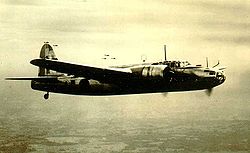Nakajima Ki-49
| Nakajima Ki-49 "Donryu" | |
|---|---|

|
|
| Type: | bomber |
| Design country: | |
| Manufacturer: | |
| First flight: |
August 1939 |
| Commissioning: |
Autumn 1941 |
| Production time: |
1941 to 1945 |
| Number of pieces: |
819 |
The Nakajima Ki-49 "Donryu" ( Japanese 中 島 キ -49 呑 龍 ) (Storm Dragon) was an aircraft used as a bomber by Japan during World War II , which was developed to replace the Mitsubishi Ki-21 bomber. The Allied code name was "Helen".
development
The first model was the Ki-49 I with two 1250 hp engines and was delivered from autumn 1941. In the spring of 1942 the prototypes of the Ki-49 II version were flying with more powerful engines and bulletproof tanks. The third version, the Ki-49 III, with further improved engines, did not get beyond the prototype status. The aircraft was improved several times during production as it repeatedly showed weaknesses in performance and armor protection. A total of 819 machines were built. In the later course of the war, the Ki-49 was mostly only used as a troop transport , for anti-submarine defense or for kamikaze missions.
Technical specifications
| Parameter | Data (Nakajima Ki-49 IIa) |
|---|---|
| crew | 8th |
| length | 16.50 m |
| span | 20.42 m |
| height | 4.25 m |
| Wing area | 69.05 m² |
| Wing extension | 6.0 |
| payload | 1,000 kg bombs |
| Empty mass | 6,530 kg |
| Max. Takeoff mass | 11,400 kg |
| Wing wing loading | 95 kg / m² |
| Marching speed | 350 km / h |
| Top speed | 492 km / h at an altitude of 5,000 m |
| Service ceiling | 9,300 m |
| Range | 2,950 km |
| Max. Flight duration | 8.40 h |
| Engines | two 14-cylinder radial engines Nakajima Ha-109 with 1,500 HP each (approx. 1,100 kW) |
| Armament | a 20-mm automatic cannon Ho-1 five 7.7-mm type 89 machine guns |
